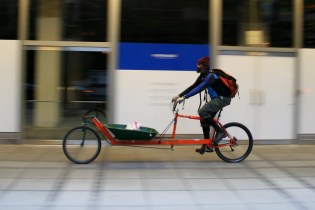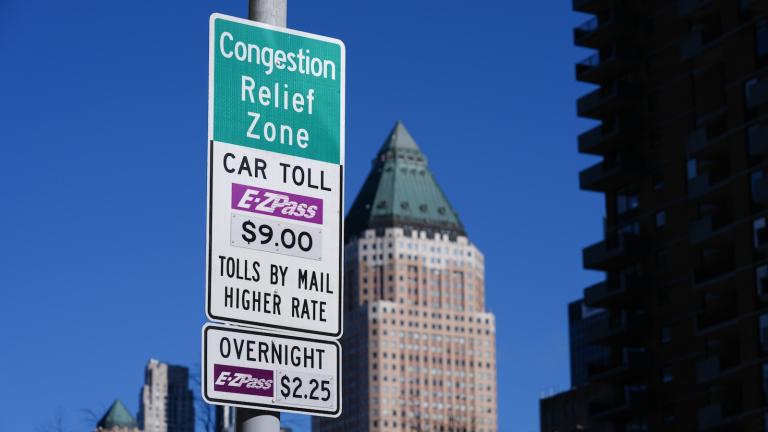
Longtime Washington, D.C., bike messenger "Scrooge" test-driving the author's Dutch Style “bakfiet” cargo bike.
From behind a windshield, my Dutch-style “bakfiet” cargo bike must look like an oddity. My multitalented artist friend Adam Zopf and I built these bikes for ourselves a few winters back. We cut two bikes in half and welded them back together with a long metal bar stretching out the wheelbase. A long steering bar extends from the handlebars all the way to the front fork, allowing the rider to turn the front wheel from the back of the bike. My bakfiet is outfitted with an old wheelbarrow tray acquired through Freecycle, handy for carrying anything too big for a backpack. Adam’s has a “flat bead” for lugging his work gear around that can be mounted with wicker chairs for his wife Regina and their young son Theo. It’s Dutch cycling chic with a little Fat Albert and the Gang twist.
To an outsider, these unusual-looking bikes probably seem like the product of some weird cycling subculture, but the cargo bike is no “tall bike.” This is the true “sport utility vehicle”; its function is its fashion. As practical as a normal bicycle can be for transportation, there are times when a backpack or a rear cargo rack is just not enough to do the job. But with a cargo bike, you can carry a small person (or two), a dog, a full load of groceries — or a keg instead of a six-pack. It really increases the practicality of the bicycle in everyday life. I am certain that we will see more and more people using different styles of cargo bikes in years to come.
Here in Washington, D.C., where I live, it is not uncommon to see a cluster of Xtra-cycles — bikes modified with extended back ends — locked up in front of the public pool or loaded down with organic produce at farmers markets. On weekends, the bike paths that feed out of the city often carry kids in pull-behind trailers and on trail-a-bikes, which attach to an adult cyclist’s seat post, turning the bike into a three-wheeled tandem. In the evenings, you might spot a smiling couple with a woman riding side-saddle on the back of an Xtra-cycle as they shirk the hassle of finding parking and just roll up to their destination and lock their bike.

Valentine's Day treats, delivered by bike.
A few Washingtonians even make a living on their cargo bikes, including a handful of bicycle messengers who specialize in delivering packages larger than envelopes. One messenger, Rodney Smith, pulls a metal-framed trailer behind his retrofitted mountain bike; Michael Pearce, a.k.a. Cargo Mike, pulls a low-priced flatbed trailer behind his Surly fixed-gear; while Scrooge makes deliveries on a production bakfiet. There are also the three-wheeled pedi-cabs swarming around downtown giving tourists a more leisurely open-air option than riding in a stuffy old taxicab.
Not everyone has a friend with the twisted artistic genius to weld a bakfiet out of a few old beater bikes and some scrap metal. But there are other options. Factory-made bikes once only available through European imports are now becoming commonplace in American bike shops. Companies like Civia Cycles out of Bloomington, Minn., are offering fantastic cargo bike options like their cycle truck, the Halsted. Larger companies like Trek and Kona are making long bike options, eliminating the need for the Xtra-cycle add-on. Then there are a number of cargo bike options from custom frame builders out of Portland, Ore.
It’s enough to make you believe San Francisco-based filmmaker and designer Liz Canning when she calls the rise of cargo bikes “a cultural revolution in progress.” Canning, who co-produced the award-winning documentary American Blackout, about the stealing of elections, and created animation pieces for Girls Rock, a film about young girls at a rock-n-roll camp, is currently collecting film footage of cargo bike culture from people all over the U.S. for a crowdsourced documentary titled (R)Evolutions Per Minute: Cargo Bikes in the U.S. Here’s the trailer, with details about how you can participate:
Over the years, I have used a variety of cargo bikes. When my boys were toddlers I towed them around town in a classic yellow Burley trailer. As they grew, my older son would ride his own bike and my younger son would ride on a trail-a-bike. When my younger son was comfortable riding his own bike, the Burley or Bob trailer would carry soccer balls, Frisbees, Nerf Guns, unicycles — whatever we needed. Then came the bakfiet, which quickly eliminated my need to use any of my pull-behind options.

The author on his homemade “bakfiet.”
A few times a year I even get to play bike messenger when Cargo Mike goes on vacation or just needs an extra hand. His primary client, Edible Arrangements, sells baskets of fruit cut to look like bouquets of flowers, and for the past couple of years, around Valentine’s Day, I’ve spent several days hustling around downtown D.C. with my wheelbarrow tray loaded down with ornate fruit baskets of chocolate-dipped strawberries and pineapples cut into the shape of flowers.
My big rig is useful, but it is also a joy to ride. It mixes performance with performance art. Without fail, at each stop, someone stops me to ask questions about this obviously homemade machine. Camera phones are pulled out and photos are taken. Contractors ask design questions. I don’t mind the attention. That’s part of the reason I ride this bike: to spread the good word of the cargo bike and try to help others to see how a bike similar to mine could fit into their lives.



